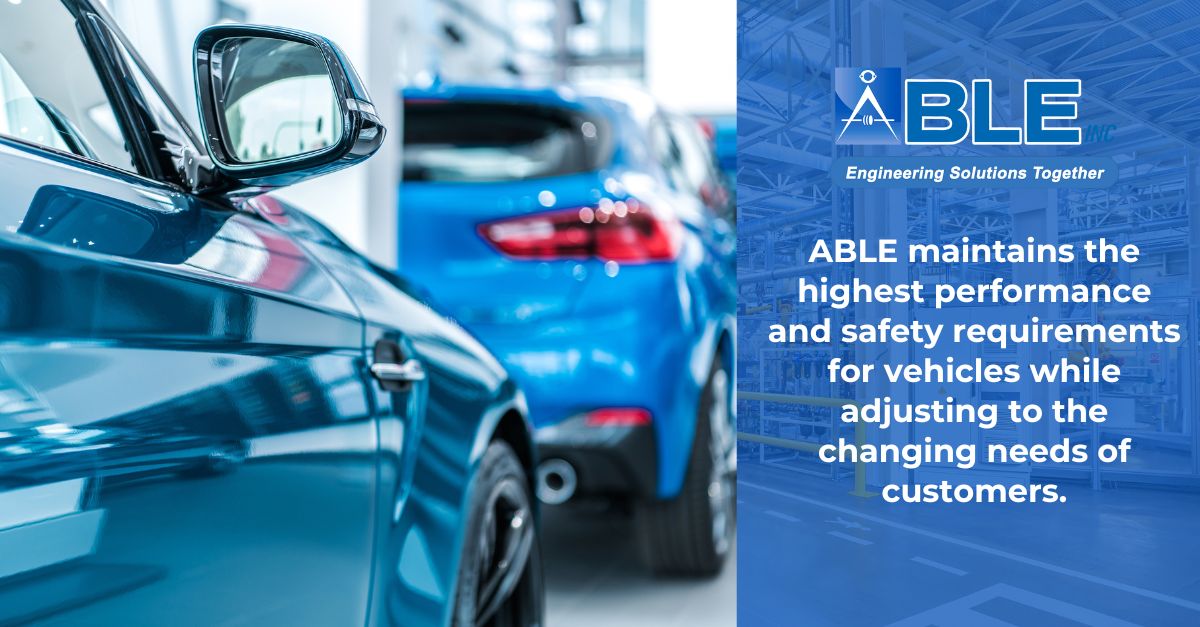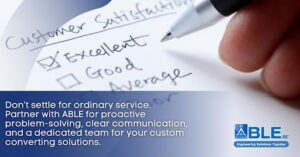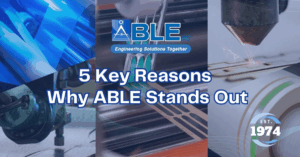Enhancing Automotive Performance: ABLE’s Leading Automotive Converting Solutions

Driven by innovation and a never-ending attempt for efficiency, safety, and performance, the automotive industry is a vibrant and competitive business. Manufacturers are always coming up with lighter, more durable, and sharper technology to satisfy the evolving demands of customers.
Automotive converting solutions are crucial for turning raw materials into parts that improve the performance, durability, and noise level of vehicles. This article explores automotive converting solutions provided by ABLE and its partners in the automotive industry.
What is Material Converting in Automotive?
Material converting in automotive involves transforming raw materials into specific forms or products for vehicle manufacturing, using techniques like slitting, laminating, die-cutting, and coating. These processes ensure materials meet precise requirements for enhanced performance and functionality. Converting is crucial for preparing materials for their intended automotive applications, such as creating tapes, protective films, and gaskets.
ABLE’s Custom Converting Solutions for the Automotive Industry
- Slitting: It involves cutting wide material rolls into thinner strips. It’s essential for cutting materials to precise widths required for additional processing or final application. It is used in the production of foils, tapes, films, and other narrow-width products.
- Laminating: Combines multiple layers of materials to form a single composite material with enhanced properties such as increased strength, durability, or insulation. It is often used in insulating materials and protective films.
- Die-cutting: Uses a die to cut materials into precise shapes and sizes. This capability’s exceptional accuracy and consistency make creating complex or repeating designs easy. Manufacturers use it to produce seals, gaskets, decals, and other precisely measured parts.
- Coating: This involves applying a layer of material onto a substrate to improve its properties, such as enhancing protection, adding adhesive qualities, or providing specific functionalities. They were used in the production of protective films, adhesive tapes, and sound-dampening materials.
ABLE’s Automotive Converting Materials
Adhesives and Tapes
Adhesives and tapes are crucial in the automotive industry for bonding and sealing various components. They can be customized for certain applications to improve performance and longevity, and they offer strong adhesion.
Examples of Use
- Trim Attachment: Used to attach interior and exterior trim pieces securely to the vehicle body, ensuring a clean, durable finish.
- Weatherstripping: Provides a seal around doors and windows to prevent water, air, and noise intrusion, enhancing comfort and protection.
Foams and Insulation
Foams and insulation materials are essential in reducing noise and managing thermal conditions within vehicles. These materials absorb sound and insulate against heat, improving the overall driving experience.
Examples of Use
- Soundproofing: Used in the vehicle cabin and engine compartment to reduce road noise, engine noise, and vibrations, providing a quieter ride.
- Heat Shields: Installed in areas exposed to high temperatures, such as the engine bay, to protect components and manage heat distribution.
Films and Laminates
Various surfaces receive films and laminates for protection and decorative purposes. They improve the vehicle’s appearance and provide a barrier of defense from damage, UV rays, and environmental damage.
Examples of Use
- Paint Protection Films: Transparent films are applied to the vehicle’s exterior to protect the paint from scratches, chips, and other damage.
- Interior Trim: Decorative laminates are used on dashboard panels, door trims, and other interior surfaces to provide a premium look and feel.
Rubber and Elastomers
Rubber and elastomers are essential for vibration dampening and creating effective seals within the vehicle.
Examples of Use
- Gaskets: Used in engine components, exhaust systems, and other critical areas to create airtight seals and prevent leaks.
- Seals: Applied around windows, doors, and other openings to prevent water and air intrusion, enhancing vehicle integrity and comfort.
Nonwoven Fabrics
Automotive applications use nonwoven fabrics for filtration and structural reinforcement. They offer excellent filtration capabilities and can reinforce components to improve strength and durability.
Examples of Use
- Cabin Air Filters: Used to filter out dust, pollen, and other particles from the air entering the vehicle cabin, improving air quality.
- Structural Reinforcements: Applied in various parts of the vehicle to enhance structural integrity and support, contributing to overall safety and performance.
Driving Performance and Safety: ABLE’s Automotive Converting Applications
- Anti-squeak & rattle: Prevents noises from friction between parts, enhancing driving comfort.
- Noise control: Reduces unwanted sounds inside the vehicle for a quieter cabin.
- Vibration dampening: Absorbs vibrations to improve ride comfort and protect components.
- Shock absorption: Cushions impact to protect the vehicle and occupants.
- Paint masking (high temperature): Covers areas during painting, and withstands high temperatures.
- Motor mount gaskets: Isolates engine vibrations, enhancing stability and reducing noise.
- Speaker gaskets: Seals around speakers to prevent vibrations and improve sound quality.
- Sound dampening: Reduces noise levels by absorbing sound energy.
- Low fogging adhesives: Minimizes volatile release to prevent window fogging and improve air quality.
- Cap seals for headlights: Protects headlights from moisture and dust.
- Battery pressure pads: Absorbs shocks and vibrations to protect the battery.
- Interior & exterior mounting: Secures components inside and outside the vehicle for stability.
ABLE’s Industry-Leading Partners for Automotive Converting Solutions
ABLE collaborates with industry company leaders like Saint-Gobain, 3M, and Rogers Corporation to deliver cutting-edge automotive solutions. These partnerships use modern materials and cutting-edge technology to address noise abatement, vibration damping, and environmental stability. ABLE maintains the highest performance and safety requirements for vehicles while adjusting to the changing needs of customers.
Material converting is essential in the automotive industry, allowing the conversion of raw materials into specialized components that enhance vehicle performance and functionality. ABLE’s partnerships with Saint-Gobain, 3M, and Rogers Corporation demonstrate their commitment to providing solutions that are essential for developing automotive technology. These partnerships enhance efficiency and innovation, guaranteeing that automobiles satisfy strict requirements while meeting evolving customer demands.
Contact ABLE today to leverage our cutting-edge automotive converting solutions!
References:
https://www.tpcconverting.com/industries/automotive/
https://able123converting.com/applications/
https://pinnacleconverting.com/converting-blog/how-converting-is-used-in-the-auto-industry/
https://able123converting.com/blog/able-automotive-solutions-excellence-in-partnership-and-industry-leading-products/
https://able123converting.com/blog/automotive-solutions-partnering-with-the-best-to-address-vibration-management/






